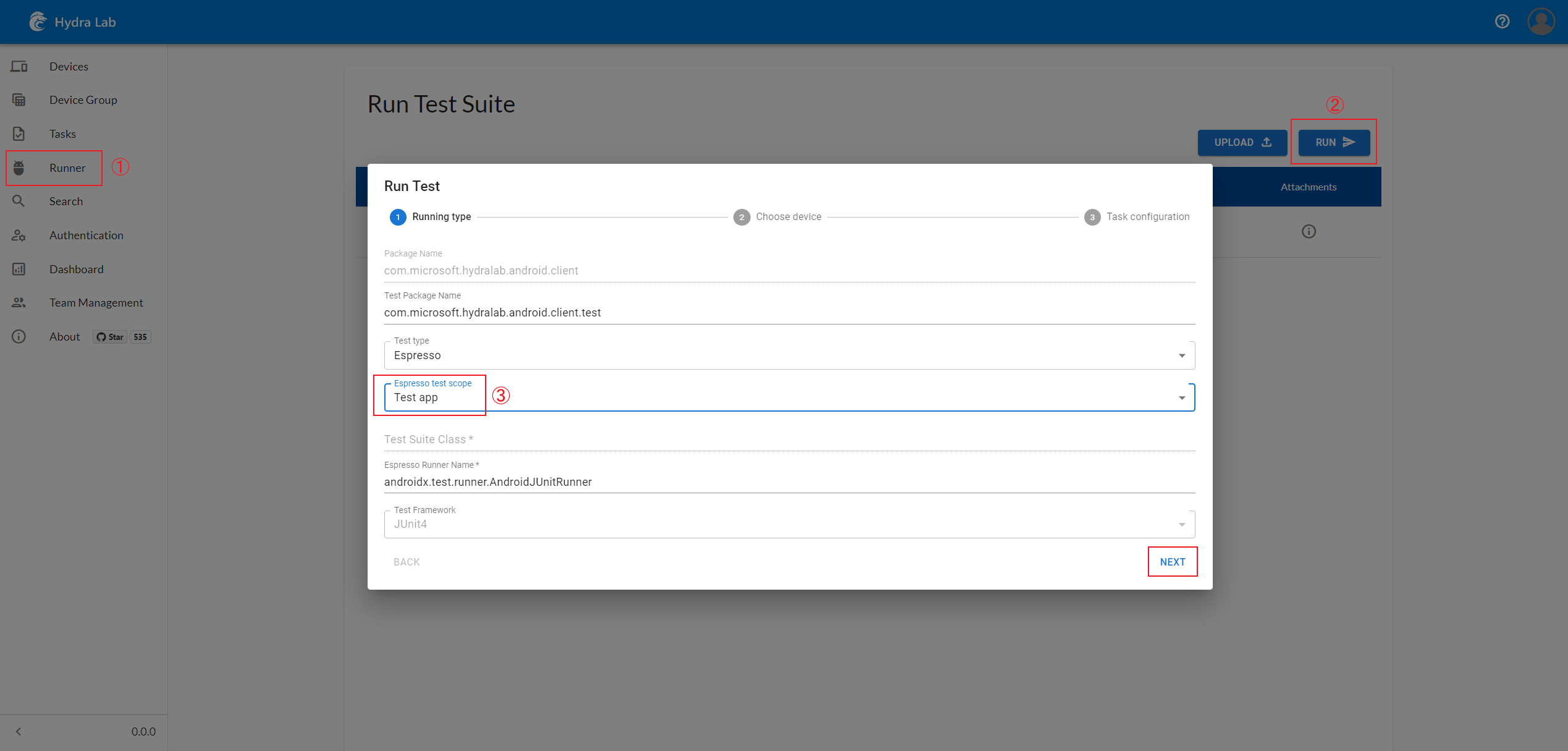Build your own cloud testing infrastructure
Hydra.Lab.External.With.Subtitle.mp4
What is Hydra Lab? | Get Started | Contribute | Contact Us | Wiki
As mentioned in the above video, Hydra Lab is a framework that can help you easily build a cloud-testing platform utilizing the test devices/machines in hand.
Capabilities of Hydra Lab include:
- Scalable test device management under the center-agent distributed design; Test task management and test result visualization.
- Powering Android Espresso Test, and Appium(Java) test on different platforms: Windows/iOS/Android/Browser/Cross-platform.
- Case-free test automation: Monkey test, Smart exploratory test.
For more details, you may refer to:
- Introduction: What is Hydra Lab?
- How Hydra Lab Empowers Microsoft Mobile Testing and Test Intelligence
Please visit our GitHub Project Wiki to understand the dev environment setup procedure: Contribution Guideline.
Supported environments for Hydra Lab agent: Windows, Mac OSX, and Linux (Docker).
Supported platforms and frameworks matrix:
| Appium(Java) | Espresso | XCTest | Maestro | Python Runner | |
|---|---|---|---|---|---|
| Android | ✔ | ✔ | x | ✔ | ✔ |
| iOS | ✔ | x | ✔ | ✔ | ✔ |
| Windows | ✔ | x | x | x | ✔ |
| Web (Browser) | ✔ | x | x | x | ✔ |
Hydra Lab offers an out-of-box experience of the Docker image, and we call it Uber. You can follow the below steps and start your docker container with both a center instance and an agent instance:
Step 1. Download and install Docker
Step 2. Download latest Uber Docker image
docker pull ghcr.io/microsoft/hydra-lab-uber:latestThis step is necessary. Without this step and jump to step 3, you may target at the local cached Docker image with latest tag if it exists.
Step 3. Run on your machine
By Default, Hydra Lab will use the local file system as a storage solution, and you may type the following in your terminal to run it:
docker run -p 9886:9886 --name=hydra-lab ghcr.io/microsoft/hydra-lab-uber:latestWe strongly recommend using Azure Blob Storage service as the file storage solution, and Hydra Lab has native, consistent, and validated support for it.
Step 3. Visit the web page and view your connected devices
Url: http://localhost:9886/portal/index.html#/ (or your custom port).
Enjoy starting your journey of exploration!
Step 4. Perform the test procedure with a minimal setup
Note: For Android, Uber image only supports Espresso/Instrumentation test. See the "User Manual" section on this page for more features: Hydra Lab Wikis.
To run a test with Uber image and local storage:
- On the front-end page, go to the
Runnertab and selectHydraLab Client. - Click
Runand change "Espresso test scope" toTest app, clickNext. - Pick an available device, click
Nextagain, and clickRunto start the test. - When the test is finished, you can view the test result in the
Tasktab on the left navigator of the front-end page.
You can also run the center java Spring Boot service (a runnable Jar) separately with the following commands:
The build and run process will require JDK11 | NPM | Android SDK platform-tools in position.
Step 1. Run Hydra Lab center service
# In the project root, switch to the react folder to build the Web front.
cd react
npm ci
npm run pub
# Get back to the project root, and build the center runnable Jar.
cd ..
# For the gradlew command, if you are on Windows please replace it with `./gradlew` or `./gradlew.bat`
gradlew :center:bootJar
# Run it, and then visit http://localhost:9886/portal/index.html#/
java -jar center/build/libs/center.jar
# Then visit http://localhost:9886/portal/index.html#/auth to generate a new agent ID and agent secret.If you encounter the error:
Error: error:0308010C:digital envelope routines::unsupported, set the System VariableNODE_OPTIONSas--openssl-legacy-providerand then restart the terminal.
Step 2. Run Hydra Lab agent service
# In the project root
cd android_client
# Build the Android client APK
./gradlew assembleDebug
cp app/build/outputs/apk/debug/app-debug.apk ../common/src/main/resources/record_release.apk
# If you don't have the SDK for Android ,you can download the prebuilt APK in https://github.com/microsoft/HydraLab/releases
# Back to the project root
cd ..
# In the project root, copy the sample config file and update the:
# YOUR_AGENT_NAME, YOUR_REGISTERED_AGENT_ID and YOUR_REGISTERED_AGENT_SECRET.
cp agent/application-sample.yml application.yml
# Then build an agent jar and run it
gradlew :agent:bootJar
java -jar agent/build/libs/agent.jarStep 3. visit http://localhost:9886/portal/index.html#/ and view your connected devices
- Test agent setup
- Trigger a test task run in the Hydra Lab test service
- Deploy Center Docker Container
Your contribution to Hydra Lab will make a difference for the entire test automation ecosystem. Please refer to CONTRIBUTING.md for instructions.
You can reach us by opening an issue or sending us mails.
Thank you for your contribution to Microsoft employee giving program in the name of Hydra Lab:
@Germey(崔庆才), @SpongeOnline(王创), @ellie-mac(陈佳佩), @Yawn(刘俊钦), @White(刘子凡), @597(姜志鹏), @HCG(尹照宇)
The entire codebase is under MIT license.
This project may contain trademarks or logos for projects, products, or services. Authorized use of Microsoft trademarks or logos is subject to and must follow Microsoft’s Trademark & Brand Guidelines. Use of Microsoft trademarks or logos in modified versions of this project must not cause confusion or imply Microsoft sponsorship. Any use of third-party trademarks or logos are subject to those third-party’s policies.
We use the Microsoft Clarity Analysis Platform for front end client data dashboard, please refer to Clarity Overview and https://clarity.microsoft.com/ to learn more.
Instructions to turn off the Clarity:
Open MainActivity, comment the line which call the initClarity(), and rebuild the Hydra Lab Client apk, repalce the one in the agent resources folder.



